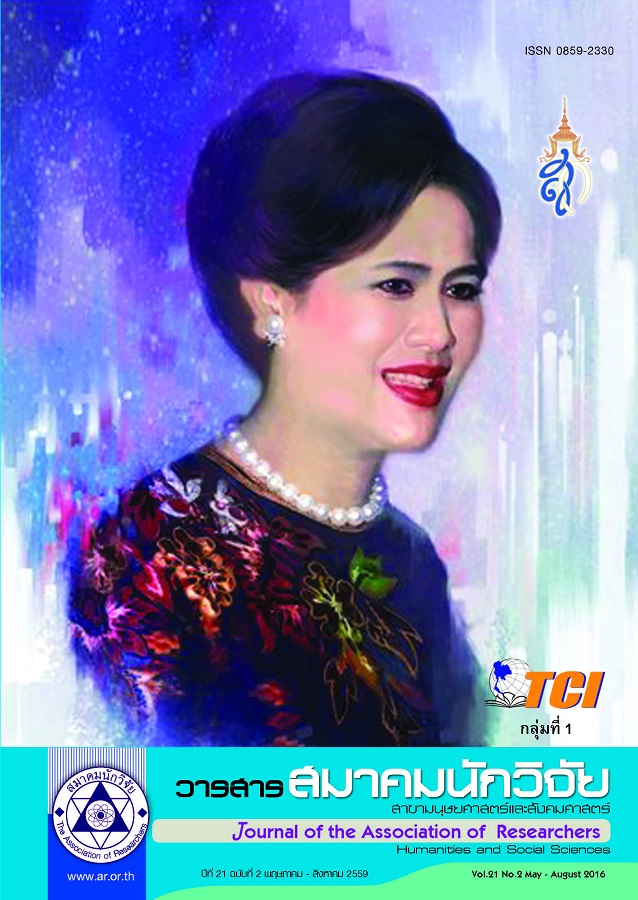Spatial Ability Test for Upper-Elementary School Student: Confirmatory Factor and Normative Data Analysis
Main Article Content
Abstract
The purpose of this study was to develop spatial ability test for elementary school children, to verify the construct validity, and to derive norms of the test. The sample consisted of 438 upperelementary school students of Piboonbumpen Demonstration School, Burapha University. Students were randomly selected by multistage sampling. Descriptive statistics were obtained by means of SPSS. The construct validity was verified by means of a second-order confirmatory factor analysis using Mplus. The research finding the spatial ability test consisted of 3 components such as spatial visualization, spatial orientation, and spatial relations. The Kuder Richardson 20 Coefficient of reliability (KR-20) of the test is .82. The test has strong construct validity in view of the fit indexes RMSEA = .02, CFI = .98, TLI = .98 resulting from confirmatory factor analysis with categorical factor indicators. The norms for spatial ability test for elementary school children were constructed as follows: a student with a score range at 12 or lower was indicative of a low level of spatial ability, a score range from 13 to 20 indicated a moderate of spatial ability, and a score range at 21 or higher was deemed to have a high level of spatial ability.
Article Details
บทความที่ปรากฏในวารสารนี้ เป็นความรับผิดชอบของผู้เขียน ซึ่งสมาคมนักวิจัยไม่จำเป็นต้องเห็นด้วยเสมอไป การนำเสนอผลงานวิจัยและบทความในวารสารนี้ไปเผยแพร่สามารถกระทำได้ โดยระบุแหล่งอ้างอิงจาก "วารสารสมาคมนักวิจัย"
References
Clem, D. W., Donaldson, J., Curs, B., Anderson, S., & Hdeib, M. (2013). Role of spatial ability as a probable ability determinant in skill acquisition for sonographic scanning. Journal of Ultrasound in Medicine, 32(3), 519-528.
Ekstrom, R. B., French, J. W., Harman, H., & Derman, D. (1976). Kit of factorreferenced cognitive tests. Princeton: Educational Testing Service.
Fornell, C. (1981). Structural equation models with unobservable variables and measurement error : algebra and statistics. Journal of marketing Research, 18(1), 39-50.
Gardner, H. (2011). Frames Of Mind: The Theory Of Multiple Intelligences (3rd ed.). USA: BasicBooks, A Member of The Perseus Books Group.
Hair Jr., J. F., Black, W., Babin, B., & Anderson, R. E. (2010). Multivariate data analysis: A global perspective. USA: Pearson.
Hegarty, M., & Waller, D. A. (2004). A dissociation between mental rotation and perspective-taking spatial abilities. Intelligence, 32(2), 175-191.
Kell, H. J., Lubinski, D., Benbow, C. P., & Steiger, J. H. (2013). Creativity and technical innovation: spatial ability’s unique role. Psychological Science, 24(9), 1831-1836.
Kerkman, D. D., Wise, J. C., & Harwood, E. A. (2000). Impossible “mental rotation” problems: A mismeasure of women’s spatial abilities? Learning and Individual Differences, 12(3), 253-269.
Kersh, M. E., & Cook, K. H. (1979). Improving mathematics ability and attitude, a manual. Seattle: Mathematics Learning Institute, University of Washington.
Linn, M. C., & Petersen, A. C. (1985). Emergence and Characterization of Sex Differences in Spatial Ability: A Meta-analysis. Child Development, 56(6), 1479-1498.
Lohman, D. F. (1988). Spatial abilities as traits, processes, and knowledge. In R. J. Sternberg (Ed.), Advances in the psychology of human intelligence (pp. 181-248).
Hillsdale, NJ: Erlbaum. Lohman, D. F. (1996). Spatial Ability and G. In I. Dennis & P. Tapsfield (Eds.), Human Abilities: Their Nature and Measurement (pp. 97-116).
Mahwah, NJ: Lawrence Erlbaum Associates. Maccoby, E. E., & Jacklin, C. N. (1974). The psychology of sex differences. Stanford: Stanford University Press.
McGee, M. G. (1979). Human spatial abilities: Sources of sex differences. New York: Praeger.
Montello, D. R., Lovelace, K. L., Golledge, R. G., & Self, C. M. (1999). Sex-related differences and similarities in geographic and environmental spatial abilities. Annals of the Association of American Geographers, 89(3), 515-534.
Newton, P. (2009). Spatial ability. Retrieved from http://www.psychometric-success.com. Pazzaglia, F., & Moe, A. (2013). Cognitive styles and mental rotation ability in map learning. Cognitive Processing, 14(4), 391-399.
Pietsch, S., & Jansen, P. (2012a). Different mental rotation performance in students of music, sport and education. Learning and Individual Differences, 22(1), 159-163.
Pietsch, S., & Jansen, P. (2012b). The relationship between coordination skill and mental rotation ability. In C. Stachniss, K. Schill, & D. H. Uttal (Eds.), Spatial Cognition VIII: Volume of the series Lecture Notes in Computer Science (Vol. 7463, pp. 173–181).
Pittalis, M., & Christou, C. (2010). Types of reasoning in 3D geometry thinking and their relation with spatial ability. Educational Studies in Mathematics, 75(2), 191-212.
Smith, T. R., Pellegrino, J. W., & Golledge, R. G. (1982). Computational process modeling of spatial cognition and behavior. Geographical analysis, 14(4), 305-325.
Tartre, L. A. (1990). Spatial orientation skill and mathematical problem solving. Journal for Research in Mathematics Education, 21(3), 216-229.
Thompson, N. A. (2010). KR-20. In N. Salkind (Ed.), Encyclopedia of Research Design (pp. 668-669). Thousand Oaks, CA: SAGE Publications, Inc.
Turgut, M., & Yilmaz, S. (2012). Relationships among preservice primary mathematics teachers’ gender, academic success and spatial ability. International Journal of Instruction, 5(2), 5-20.
Uttal, D. H., & Cohen, C. A. (2012). Spatial thinking and STEM education: when, why, and how? In B. Ross (Ed.), Psychology of Learning and Motivation (pp. 147-181).
San Diego: Academic Press. Vogel, J. J., Bowers, C. A., & Vogel, D. S. (2003). Cerebral lateralization of spatial abilities: A meta-analysis. Brain and Cognition, 52(2), 197-204.
Wiersma, W., & Jurs, S. G. (1990). Educational measurement and testing. Boston: Allyn and Bacon.


